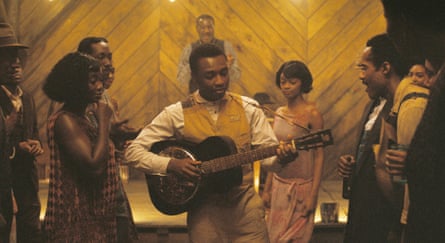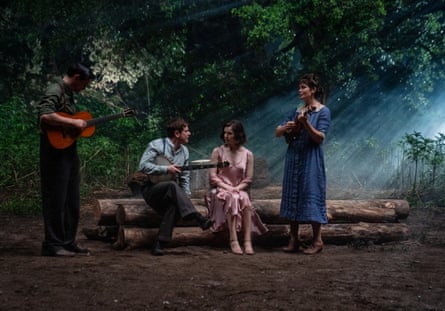Ryan Coogler’s Sinners just notched the biggest opening weekend for an original movie since the start of the pandemic, which means the Michael B Jordan-starring, period-set vampire movie will be seen and talked about for weeks (and more) to come. Here are some absolutely spoiler-packed discussion points (seriously, multiple endings are spoiled!) for the film’s variety of layers, genres and readings.
Crime drama vs vampire horror
Whenever a movie has an unusual genre mix or bifurcated structure – and Sinners has both – there will be viewers who prefer one half to the other. Coogler’s film is a relatively leisurely crime-adjacent drama for its first half, following brothers Smoke and Stack (both Michael B Jordan) as they attempt to parlay their gangsters’ bounty into a juke joint for their Mississippi community. Then it turns into more of a horror movie, when vampires, apparently drawn out by the supernatural quality of the brothers’ musician cousin Sammie (Miles Caton), show up at the club and try to turn the patrons to their undead army. And the club scenes mean that the movie briefly resembles a performance musical on its way to the horror-action stuff.
The temptation with this many genres in play is often to choose a team: why didn’t they get to the awesome vampire stuff faster? Or, why did they spoil that great character-building with a bunch of horrific action? Or, why wasn’t the whole thing a blues musical? But Coogler in his very form seems to reject the hard lines of separation that audiences sometimes want to impose on material like this – which is a particularly interesting technique for him, given the movie’s complicated portrayal of cultural blending. In a way, it feels like Coogler is reclaiming the mixed-and-matched genre space from his former (and possibly future) employers at Marvel, where movies often purport to belong to some highly specific (and sometimes nonexistent) genre, only to play primarily like those elements have been overstirred into a gray mush. I don’t think Coogler particularly meant Sinners as a rebuke to the Marvel Method, but it’s nonetheless inspiring to see how the movie lets its genres overlap while still allowing crucial elements – the flowing blood of horror, the ecstasy of the musical, the process of a crime picture – to stick out as conspicuously as possible.
Seeing double

As mentioned, Michael B Jordan plays two roles here – the latest actor to do so in 2025, after Robert Pattinson, as clones in the future; and Robert De Niro, as two completely different people in the past. (Is Warner Bros, the studio that released all three of these movies, simply taking their name too literally?) Jordan is a good actor and an even better movie star, and his double act depends more on the latter. Smoke and Stack are clearly different, but Jordan isn’t giving the type of dual performance where you can instantly recognize either one based entirely on mannerisms, vocal affect, or posture. (Neither was De Niro, in case you were curious about a far more misbegotten double-gangster turn.)
Instead, Jordan and Coogler use the characters’ twinning in a more mythology-friendly way; in retrospect, it feels inevitable that one brother will be turned into a vampire and the other will remain human, a neat angel/devil separation that the movie, again, complicates in its final stretch (more on that in a moment). It’s this, far more than any specific acting tricks, that differentiate the two men; the respective fates that await Smoke and Stack are difficult to imagine reversed. One of them is bound for heaven even/especially after the vengeance he wreaks upon a group of Klansmen; one is bound to make the best of eternal hell on Earth. The double casting also serves as a canny workaround for Jordan’s charisma; Caton’s character eventually emerges as central, and while that could probably happen with Smoke and Stack recombined into a single character (Caton is very good), having two Jordans on hand is a way of ensuring the movie isn’t thrown off balance – that the audience doesn’t get antsy when Jordan is offscreen, because he rarely is.
The magic of music

About halfway through the movie, Coogler stages a more impressionistic sequence, where the ecstasy of the music played by Sammie and veteran musician Delta Slim (Delroy Lindo) gives way to both fiery imagery and orgiastic visions of music past and future, including African and Asian dancers, a Funkadelic-style guitarist, and a DJ spinning records. Even in a genre-mixing, sprawling film, it’s a bold, extended gambit, bringing some Baz Luhrmann into a mix that includes more traditional horror/action/genre directors like John Carpenter and Robert Rodriguez. In what is already one of the year’s most talked-about shots, Coogler’s camera – capturing images popped out to full, towering 4:3 aspect ratio for those lucky enough to see it on a classic, gigantic Imax screen – snakes around the club, taking in the whirl of music, dance, and color. As indulgent as it might seem (and it is indulgent, in the best, most crowd-levitating way), it’s also a form of shorthand for the earthly paradise this community experiences for one wild night, before it comes crashing down.
Vampiric assimilation

The music at the center of Sinners is given a divine-like connection to the other side; it “pierces the veil” and seemingly attracts the attention of the lead vampire Remmick (Jack O’Connell), who’s quite steeped in music himself, of the Irish folk variety. Remmick and his recently vamp-converted fellow white folks (including Lola Kirke from Mistress America!) show up at the club not to menace everyone, at least not initially, but to politely ask for an invitation to join the party. (These vampires, like many others in other lore, can’t enter a building unless invited directly.) The community rebuffs them, but when Mary (Hailee Steinfeld), a mixed-race woman like kin to many of the Black folks on hand, reaches out to them, hoping for some possible patronage, they turn her; she, of course, is invited back into the joint, and thus begins the true havoc.
This setup evokes a variety of racial politics and potential readings. The most obvious one casts the white characters as a literalized version of cultural vampires, attracted by the undeniable allure of another group’s music and eager to suck the life from it. The fact that they attack the Black characters at night (like Ku Klux Klan members), only without masks, also has strong hints of institutional racism that would outlast the once-normalized hate groups (and come back around, nearly as virulent but inexplicably considered more respectable). But given that the community in question clearly welcomes non-Black members, and how plenty of non-white people are brought into the vampire fold, I read this rich metaphor as more to do with the process of assimilation in America. The vampires preach the value of, essentially, a hive mind that they claim offers equality for all – the drawback being, of course, that said hive mind is also controlled by its originator, not by the people absorbed into it. Sinners is bittersweet about how this process, whether through vampire-turned assimilation or simply the passage of time, can leave more self-supporting communities behind. We’re certainly relieved that Sammie escapes, defiantly holding on to the neck of his blues guitar, but it’s not lost on the audience that he’s the only one who makes it out. Well, almost.
Choose your ending

Sinners could be said to have about four different endings, broken up by end credits. The stories of Smoke, Stack and Sammie seem to end one way, with Smoke killing the vampire version of Stack, then he and Sammie triumphing over Remmick – only to bring Smoke back into the violence the next morning as he’s mortally wounded while mowing down approaching (real) Klan members. Then a during-credits epilogue – another reappropriation of the Marvel Method! – offers a time jump that further elaborate on the fates of both Sammie and Stack, who Smoke has let live in exchange for leaving Sammie be, allowing him to escape and eventually become a Buddy Guy-like blues legend. (He is literally played by Buddy Guy.) But Stack lives on, as does Mary, and briefly reunites with his now-elderly cousin after the latter’s gig in 1992. And that’s still not all! After the rest of the credits roll, there’s a postscript where we see a younger Sammie briefly playing This Little Light of Mine, which has readings related to both Christianity and to 20th century civil rights movements.
As with the genre-pivoting, a movie with this many endings is “supposed” to be doing things wrong. But Coogler takes a lot of care with his movements through ending; I used the novelistic “epilogue” above, but maybe it’s more akin to a musical coda. Either way, it allows the audience to rethink the monstrousness of Stack (and, to perhaps a lesser extent, his vampire bride Mary), who seems to have freed himself from the assimilation of the head vampire and pursued his own form of immortality. Sammie goes about it the more old-fashioned way, achieving some kind of immortality through his music. What they both agree on is that before the vampire attack went down, that day and night at the juke joint was the best of their lives, reiterating a longing for a space that was truly their own, rather than some kind of compromise with the greater American world. Maybe that final bonus moment of Sammie singing a song of optimism (contrasting with the devil-raising bliss of the blues) is supposed to be a compromise, or maybe it’s a way of wresting the “devil’s music” back for humanity. Regardless, the multiple endings are thematically appropriate; even as he teases out a sense of sadness over what’s been lost, Coogler understands that there’s no one single way this story ends.

.png) 3 hours ago
4
3 hours ago
4













































